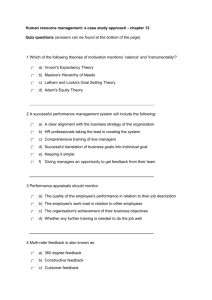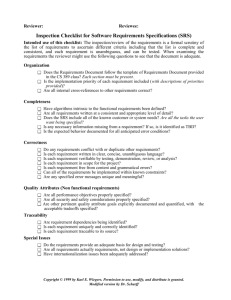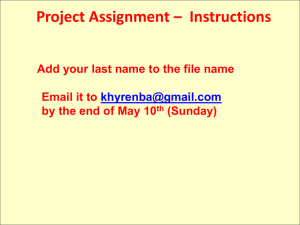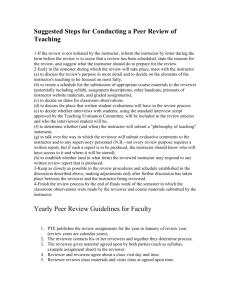VT School of Education Peer Review of Teaching
advertisement
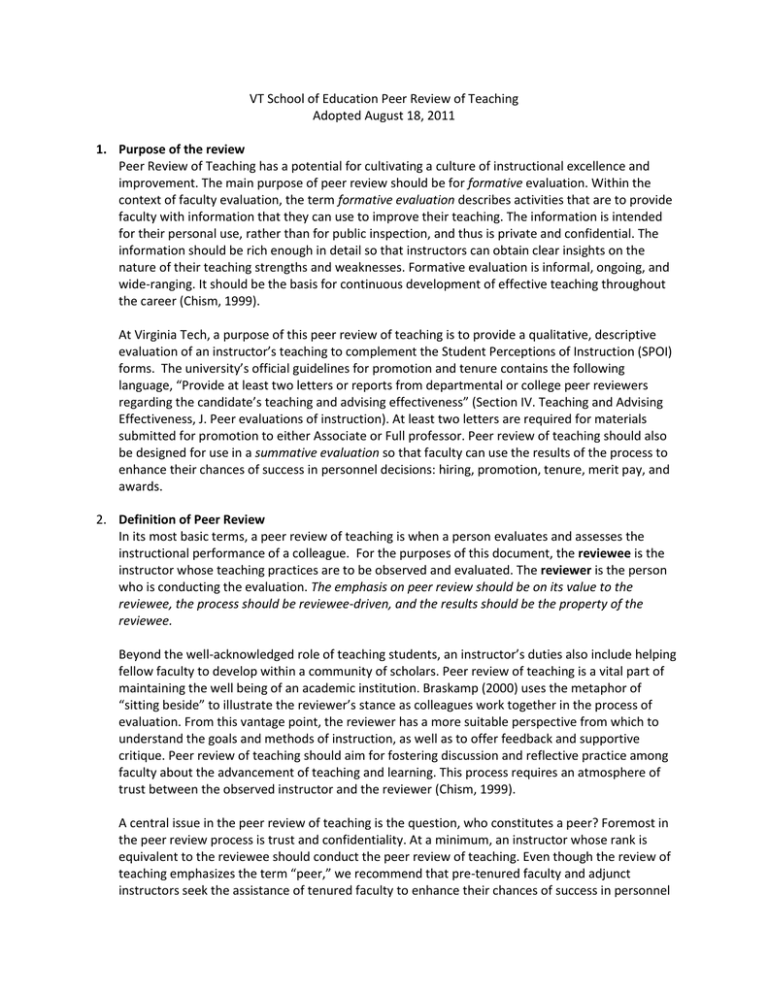
VT School of Education Peer Review of Teaching Adopted August 18, 2011 1. Purpose of the review Peer Review of Teaching has a potential for cultivating a culture of instructional excellence and improvement. The main purpose of peer review should be for formative evaluation. Within the context of faculty evaluation, the term formative evaluation describes activities that are to provide faculty with information that they can use to improve their teaching. The information is intended for their personal use, rather than for public inspection, and thus is private and confidential. The information should be rich enough in detail so that instructors can obtain clear insights on the nature of their teaching strengths and weaknesses. Formative evaluation is informal, ongoing, and wide-ranging. It should be the basis for continuous development of effective teaching throughout the career (Chism, 1999). At Virginia Tech, a purpose of this peer review of teaching is to provide a qualitative, descriptive evaluation of an instructor’s teaching to complement the Student Perceptions of Instruction (SPOI) forms. The university’s official guidelines for promotion and tenure contains the following language, “Provide at least two letters or reports from departmental or college peer reviewers regarding the candidate’s teaching and advising effectiveness” (Section IV. Teaching and Advising Effectiveness, J. Peer evaluations of instruction). At least two letters are required for materials submitted for promotion to either Associate or Full professor. Peer review of teaching should also be designed for use in a summative evaluation so that faculty can use the results of the process to enhance their chances of success in personnel decisions: hiring, promotion, tenure, merit pay, and awards. 2. Definition of Peer Review In its most basic terms, a peer review of teaching is when a person evaluates and assesses the instructional performance of a colleague. For the purposes of this document, the reviewee is the instructor whose teaching practices are to be observed and evaluated. The reviewer is the person who is conducting the evaluation. The emphasis on peer review should be on its value to the reviewee, the process should be reviewee-driven, and the results should be the property of the reviewee. Beyond the well-acknowledged role of teaching students, an instructor’s duties also include helping fellow faculty to develop within a community of scholars. Peer review of teaching is a vital part of maintaining the well being of an academic institution. Braskamp (2000) uses the metaphor of “sitting beside” to illustrate the reviewer’s stance as colleagues work together in the process of evaluation. From this vantage point, the reviewer has a more suitable perspective from which to understand the goals and methods of instruction, as well as to offer feedback and supportive critique. Peer review of teaching should aim for fostering discussion and reflective practice among faculty about the advancement of teaching and learning. This process requires an atmosphere of trust between the observed instructor and the reviewer (Chism, 1999). A central issue in the peer review of teaching is the question, who constitutes a peer? Foremost in the peer review process is trust and confidentiality. At a minimum, an instructor whose rank is equivalent to the reviewee should conduct the peer review of teaching. Even though the review of teaching emphasizes the term “peer,” we recommend that pre-tenured faculty and adjunct instructors seek the assistance of tenured faculty to enhance their chances of success in personnel SOE Peer Review of Teaching August 18, 2011 decisions such as promotion and tenure, merit pay, and awards. Peer reviewers do not need to be from the same academic discipline, although this is common. Peer review of teaching should include a holistic approach to gathering multiple sources of credible evidence that strives for clarification and understanding. Just as teaching and instruction are highly individualized activities, peer review should not be highly scripted or tightly regulated. As Braskamp (2000) argues, “the more we concentrate on a single assessment strategy (test or measure of quality or effectiveness) to improve the quality of what is being assessed, the more likely the quality will decrease rather than increase” (p. 26). Checklists, coding instruments, and observation protocols are discouraged as they can result in focusing the reviewer’s attention in a way that misses key interactions, or emphasizing elements that may not be applicable to the goals or content of the course. Data collected for a peer review may consist of, but is not limited to: Classroom observation(s); Review of syllabus and supporting course materials; Analysis of assignments and evaluation criteria; Course packets, handouts, and texts; Course Scholar site or website (when applicable); Review of examples of student work and instructor feedback; Appraisal of on-line discussions or wikis (when appropriate); and Review of on-line content (when applicable). 3. How reviews will be used and shared The reviews will be the property of the faculty member who may choose to include the review in a promotion and tenure file. The reviewer should honor confidentiality and not release the results of the peer review to anyone but the reviewee. The raw data and field notes collected during the peer review should not be included in the final report. Reviews will not become part of an individual’s personnel file nor will they be used in their faculty annual reviews (FAR). Department unit chairs or directors will not have access to the report unless the reviewee releases the report to them. For the purposes of the promotion and tenure file, reviewees are advised to include at least two reviews from different reviewers, classes and academic semesters. Not all reviews need to be included in the promotion and tenure file. 4. Establishment of Criteria for Report Writing The evaluation might include some of the following points: Course conception, organization, and presentation: The structure and pacing of the class, The instructor’s organization of the course, Opportunities for collaborative work and discussion among students, Types of presentation skills (tone, gesture, fluency, and use of space) used in course delivery, The timeliness of feedback, The clarity of the instructor’s explanations, instructions, or illustrations, and The types of technologies used in the course delivery. 2 SOE Peer Review of Teaching August 18, 2011 Course content: The appropriateness of course content and material for students’ academic level, The ways in which the instructor encourages speaking, writing, and other forms of selfexpression, The opportunities for students to reflect, relate, organize, apply, synthesize, or evaluate information, The ways in which the instructor incorporates current knowledge and research into the course, and The ways in which the instructor identifies sources, authorities, and perspective in the field. Interpersonal communication and relationships: Teacher-student rapport, Instructor facilitation of class discussions by encouraging, probing, questioning, and summarizing, How the instructor draws non-participating students into the discussion and conversely, how the instructor handles students who dominate classroom talk, The ways that the instructor acknowledges students’ contributions and expands upon their ideas, and The means by which the instructor mediates conflicts or differences of opinions. The Peer Review of Teaching Report at a minimum should include the following three sections offered in a narrative format: Descriptive Information concerning the reviewer and the course: The name of the reviewer The name of the reviewee The date of the class observation (if applicable) The date the report completion The course name, number, and CRN The number of students enrolled in the course Special context (e.g. online, field-based) The Report Narrative, which describes the kinds of data that were collected for the peer review, as well as the reviewer’s assessment. The narrative should strive for a holistic account that at a minimum, includes: A conceptual overview and the goals of the course, The kinds of materials or technologies that support student learning, The types of teaching strategies that were being used, The methods used for evaluating students’ work conducted in the course, Examples of the kinds of discussions and dialogues among the instructor and students, and the level of student interaction, and The ways in which the classroom learning activities are organized. Constructive Recommendations and suggestions for improvement of the course delivery and instruction. These recommendations should strive for a balance between praise and constructive 3 SOE Peer Review of Teaching August 18, 2011 critique. This section might address recommendations in ways that an instructor could improve the following by using these prompts (Chism, 1999): The ways in which the instructor helps develop rational thinking and problem solving ability, The means by which the instructor helps develop skills needed in the field, The features that broaden students’ views, The ways the instructor provides a healthy challenge to students’ attitudes and beliefs, The encouragement that the instructor provides to expand students’ analytical ability, The means by which the instructor helps develop students’ awareness of cultural diversity and equity, and The ways that the instructor stimulates independent thinking. 5. Reviewees’ Responsibilities Peer review of teaching should occur by invitation only; there should be no surprise observations or classroom visits. The reviewee should discuss a request with the reviewer before the semester starts, and the two should come to an agreement on a workable time during the semester for the observation. Prior to the observation, the reviewee will provide a copy of the course syllabus, along with the assignments, handouts, and readings that will be discussed in class on the agreed date. These materials can be provided at a pre-observation conference or sent directly to the reviewer through e-mail. The data used for the peer review will be negotiated between the reviewee and reviewer. Participants should determine in advance what other procedures, if any, are to be employed in assessing instructional performance. Students will be informed in advance of the observation and the reviewer will be introduced to the class as the observation begins (for both face-to-face and virtual courses). A pre-observation conference between the reviewer and reviewee is recommended and can offer helpful information for the reviewer. Information provided at this time could include: The goals for the particular class the reviewer will be observing, The plans for achieving these goals, The particular teaching and learning activities that will take place, and The ways in which this particular class is typical of one’s teaching style. Additional information that is helpful to for the reviewer includes: The academic level of students in the course (e.g., M.S. Ed.D., or Ph.D., first year in program vs. completing coursework), The linguistic diversity of the students (i.e., the presence of English Language Learners) in the course, and Ways in which special needs of students are met within the structure of the class. 6. Reviewer’s Responsibilities A request to review someone’s teaching is first and foremost a sign of respect, an acknowledgement by the reviewee that the reviewer’s teaching expertise is valued. The first responsibility of the reviewer is to respond promptly to the reviewee’s request and to make a commitment to completing the parts of the peer review process as detailed in this document. If the time suggested by the reviewee is not feasible for the reviewer, an alternative time should be discussed so that the process can proceed. Prior to the actual observation, the reviewer should meet with the reviewee, review syllabi and course assignments, discuss methods for observation, and seek to understand the 4 SOE Peer Review of Teaching August 18, 2011 context in which the observation will take place. Participants should determine in advance what other procedures, if any, are to be employed in assessing instructional performance. During the observation the reviewer should be introduced and then should observe the class and take notes without disrupting. Approximately one week after the observation the reviewer should meet with the reviewee and provide feedback to the reviewee about the observation. This post-observation meeting should cover the following information: A description of the class activities, A description of the students’ responses to class and interactions, Details about strengths of the reviewee as an instructor, Questions about the observation, and Details about areas in which the reviewer believes the reviewee could improve. A report should be delivered in digital and hard copy to the reviewee within two weeks of the observation (or of the course review for hybrid or on-line classes). 7. Timeline The peer review process should at a minimum include three parts: a) a pre-observation meeting, b) the observation, and c) a post-observation meeting. Before the semester, the reviewee invites another faculty member to observe their teaching, and agrees on a mutually convenient date at least 2-3 weeks before the intended observation. About 1 week prior to the observation the reviewer and the reviewee should participate in a pre-observation conference as described above. After the observation has taken place the reviewer and reviewee should meet to discuss the observation. This post-observation meeting should not occur directly after the class since the requisite processing and thought may not have taken place. Ideally the post observation meeting should take place within 1 week of the observation so that both reviewer and reviewee do not forget the class. A report should be delivered in digital and hard copy to the reviewee within two weeks of the observation (or of the course review for hybrid or on-line classes). 5 SOE Peer Review of Teaching August 18, 2011 Reviewee Reviewer Initiating the Review Requests a review of course before semester and agrees on mutually convenient date. Responds promptly to request and agrees on mutually convenient date Pre –Observ. Conference Meets w/reviewer about 1 week prior to observation. Observation Meets w/reviewee about 1 week prior to observation. Observes the Reviewee at the agreed upon time and place. Teaches class at the agreed upon time and place. Post-Observ. Conference 1 week after the observation. Final Report/Letter 1 week after the observation. Completes reports within 2 weeks of observation. 8. Peer review in special contexts a. Online (or hybrid) Course (Pennsylvania State University, 2010) i. The online or virtual course is unique in that the reviewer is not able to observe synchronous interactions between student and instructor. Ideally, the reviewer of an online course should be skilled in online course delivery. The same steps for Peer Review that take place in a live course should also take place in a virtual course. The reviewer and reviewee should schedule a pre-observation meeting. The reviewer then should take a period of time to “observe” the online course, following up with a post-observation meeting. A report, in digital and hard copy should be provided to the reviewee at least 2 weeks after the post-observation meeting. ii. At the pre-observation meeting, the reviewee should walk the reviewer through the course site identifying the following: 1. Syllabus 2. Announcement Areas 3. Assignments 4. Forums or other chat space 5. Blogs 6. Vlogs 7. E-mail archives 8. E-portfolios 9. Course wikis A face-to-face meeting is ideal for quickly orienting the reviewer and saving time and unnecessary e-mails. During a pre-observation meeting the reviewee should also apprise the reviewer of any special circumstances. At the end of the pre-observation meeting, the reviewer and reviewee should set a time for a post-observation meeting about 2 weeks from the pre-observation meeting. iii. During the observation window the reviewer should review the site on multiple occasions and should “observe” any synchronous communication that takes place via Skype, video conferencing or other means. In addition to the aforementioned criteria the reviewer should also evaluate the following: 6 SOE Peer Review of Teaching August 18, 2011 How the instructor initiates contact and responds to students on a regular basis; The communication of important course information; Organization of course materials; Opportunities for student to engage in discussions (e.g. forums); Modeling of good online discussion practices; How prompts are used to stimulated interaction and engagement; The nature of assignments; The nature of the feedback provided to students; A published course schedule with due dates and timelines; Explicit feedback about knowledge and skills necessary to be successful. b. Lab i. Along with the considerations noted above, the reviewer might address also the instructor’s attention to laboratory safety. ii. The reviewer might observe the ability of the instructor is able to use laboratory equipment and demonstrate its use for the students. iii. The kinds of preparation necessary for smooth laboratory operation. c. Team Teaching and Field or Supervision Classes Given the unique shared responsibilities in a team-taught course, it is best not to have a course that is team-taught be peer-reviewed. There are certain dynamics and decisions made in such a course that are unique. Similarly, courses that are field based for direct supervision of students, while important to the educational process in the School of Education, are not the ideal situation for a peer review to take place. References Braskamp, L. A. (2000) Toward a more holistic approach to assessing faculty as teachers. In K. E. Ryan (Ed.) Evaluating teaching in Higher Education: A vision for the future, pp. 19-33, San Francisco: Jossey-Bass. Chism, N. V. N. (1999). Peer review of teaching: A sourcebook. Boston: Anker Publishing Co., Inc. Pennsylvania State University (2010). A peer review guide for online courses at Penn State. State College, PA: author. Available athttps://www.eeducation.psu.edu/files/sites/file/PeerReview_OnlineCourses_PSU_Guide_Form_28Sep t2010.pdf 7
